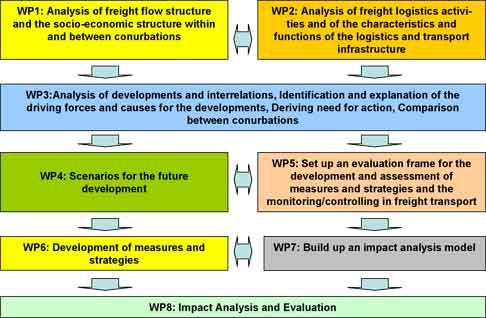NRP54: Sustainable Goods Supply and Transport in Conurbations
Funded by
Partner
Duration
2005 - 2008
Abstract
Starting Point
Over the past decades overall freight transport grew dramatically and road transport became the dominant transport mode.
In Switzerland freight transport is growing much faster than passenger transport. The main reasons are the globalisation, the changing production patterns and transport demand and the improvement of the road infrastructure. According to scenarios drawn up by the Swiss Federal Office for Spatial Planning, the total volume of freight traffic on Switzerland's roads and railways could rise from today's 24 billion tonne-kilometres a year to between 31 and 42 billion tonne-kilometres (+32% to +78%) by the year 2030. Together with the strong increase of freight transport problems arise relating to air pollution, noise, climate change and safety.
Key Problems in Conurbations
- In Swiss conurbations or urban areas live around 70 to 80% of the Swiss inhabitants. The share of freight transport in mileage compared to the whole road transport is within conurbations around 30% to 40% including vans.
- High space use and lack of suitable infrastructure for deliveries
- Lack of cooperation between logistics and transport service providers
- Critical access for goods vehicles to pedestrian zones and historic centres, conflicts with other road users during delivery operations
- Negative environmental effects such as noise emissions and pollution
- Low transport efficiency because of small consignments and time losses in congestion
- Decreasing share of rail freight transport.
Main Objectives of the Project
- Analysis of freight logistics activities and freight flow patterns within and between Swiss conurbations and their development within the last 20 years
- Analysis of the interrelation between freight transport and socio-economic structure of conurbations and derivation of driving factors
- Analysis of the characteristics and functions of logistics and transport infrastructure (private and public) and the today’s and future infrastructure needs
- Setting up an indicator scheme for evaluation of measures and monitoring/controlling for urban and regional freight transport
- Development a measures-impact model for the estimation of effects
- Development and evaluate sustainable freight logistics and transport strategies taking into account various areas of measures (e.g. infrastructural, operational, economical, land use planning measures)
- Implementation of results to support sustainable freight transport and infrastructure in conurbations.
Methods
- Literature study
- Descriptive data analysis
- Advanced statistical methods (e.g. regression analysis)
- Workshops
- Systems engineering
- Scenario methodology
- Transport Modelling and Simulation of Landuse and Transport (UrbanSim)
Project Team
- Barbara Schultz
- Michaela Bürgle
- Philipp Rütsche

